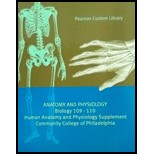
ANATOMY & PHYSIOLOGY COMM COLL PHILADELPHIA
16th Edition
ISBN: 9781323360989
Author: MARTINI & NATH
Publisher: PEARSON
expand_more
expand_more
format_list_bulleted
Concept explainers
Question
Chapter 10, Problem 6RFT
Summary Introduction
To review:
Match the term stylohyoid with the most closely related description given below:
Compresses cheeks
Elevates larynx
Tenses skin of neck
Pelvic floor/associated structures
Elevates mandible
Move ribs
Retracts tongue
Extends neck
Eye muscles
Makes eye look down
Introduction:
The muscles in the anterior of the neck perform the functions like the depression of mandible, controlling the larynx position, and providing the stable foundation for the muscles of pharynx and tongue. Stylohyoid muscle is one of the muscles that is situated in the anterior region of the neck.
Expert Solution & Answer
Want to see the full answer?
Check out a sample textbook solution
Students have asked these similar questions
What is the structure and function of Eukaryotic cells, including their organelles? How are Eukaryotic cells different than Prokaryotic cells, in terms of evolution which form of the cell might have came first? How do Eukaryotic cells become malignant (cancerous)?
What are the roles of DNA and proteins inside of the cell? What are the building blocks or molecular components of the DNA and proteins? How are proteins produced within the cell? What connection is there between DNA, proteins, and the cell cycle? What is the relationship between DNA, proteins, and Cancer?
Why cells go through various types of cell division and how eukaryotic cells control cell growth through the cell cycle control system?
Chapter 10 Solutions
ANATOMY & PHYSIOLOGY COMM COLL PHILADELPHIA
Ch. 10 - Match each numbered item with the most closely...Ch. 10 - Prob. 2RFTCh. 10 - Prob. 3RFTCh. 10 - Prob. 4RFTCh. 10 - Prob. 5RFTCh. 10 - Prob. 6RFTCh. 10 - Prob. 7RFTCh. 10 - Match each numbered item with the most | closely...Ch. 10 - Match each numbered item with the most closely...Ch. 10 - Prob. 10RFT
Ch. 10 - Prob. 11RFTCh. 10 - Prob. 12RFTCh. 10 - Prob. 13RFTCh. 10 - Prob. 14RFTCh. 10 - Which of the following describes the action of the...Ch. 10 - Prob. 16RFTCh. 10 - Prob. 17RFTCh. 10 - Prob. 18RFTCh. 10 - Prob. 19RFTCh. 10 - Prob. 20RFTCh. 10 - 21. Which cranial nerve is most likely to have...Ch. 10 - During abdominal surgery, the surgeon makes a cut...Ch. 10 - Prob. 2RCCh. 10 - Which of the following muscles plays no role in...Ch. 10 - Which of the following features are common to the...Ch. 10 - Prob. 5RCCh. 10 - What role do the muscles of the tongue play in...Ch. 10 - Prob. 7RCCh. 10 - Prob. 8RCCh. 10 - What is the function of the diaphragm? Why is it...Ch. 10 - 10. What muscles are involved in controlling the...Ch. 10 - How do the muscles of the anal triangle control...Ch. 10 - Mary sees Jill coming toward her and immediately...
Knowledge Booster
Learn more about
Need a deep-dive on the concept behind this application? Look no further. Learn more about this topic, biology and related others by exploring similar questions and additional content below.Similar questions
- In one paragraph show how atoms and they're structure are related to the structure of dna and proteins. Talk about what atoms are. what they're made of, why chemical bonding is important to DNA?arrow_forwardWhat are the structure and properties of atoms and chemical bonds (especially how they relate to DNA and proteins).arrow_forwardThe Sentinel Cell: Nature’s Answer to Cancer?arrow_forward
- Molecular Biology Question You are working to characterize a novel protein in mice. Analysis shows that high levels of the primary transcript that codes for this protein are found in tissue from the brain, muscle, liver, and pancreas. However, an antibody that recognizes the C-terminal portion of the protein indicates that the protein is present in brain, muscle, and liver, but not in the pancreas. What is the most likely explanation for this result?arrow_forwardMolecular Biology Explain/discuss how “slow stop” and “quick/fast stop” mutants wereused to identify different protein involved in DNA replication in E. coli.arrow_forwardMolecular Biology Question A gene that codes for a protein was removed from a eukaryotic cell and inserted into a prokaryotic cell. Although the gene was successfully transcribed and translated, it produced a different protein than it produced in the eukaryotic cell. What is the most likely explanation?arrow_forward
- Molecular Biology LIST three characteristics of origins of replicationarrow_forwardMolecular Biology Question Please help. Thank you For E coli DNA polymerase III, give the structure and function of the b-clamp sub-complex. Describe how the structure of this sub-complex is important for it’s function.arrow_forwardMolecular Biology LIST three characteristics of DNA Polymerasesarrow_forward
arrow_back_ios
SEE MORE QUESTIONS
arrow_forward_ios
Recommended textbooks for you
 Human Biology (MindTap Course List)BiologyISBN:9781305112100Author:Cecie Starr, Beverly McMillanPublisher:Cengage Learning
Human Biology (MindTap Course List)BiologyISBN:9781305112100Author:Cecie Starr, Beverly McMillanPublisher:Cengage Learning Principles Of Radiographic Imaging: An Art And A ...Health & NutritionISBN:9781337711067Author:Richard R. Carlton, Arlene M. Adler, Vesna BalacPublisher:Cengage Learning
Principles Of Radiographic Imaging: An Art And A ...Health & NutritionISBN:9781337711067Author:Richard R. Carlton, Arlene M. Adler, Vesna BalacPublisher:Cengage Learning Anatomy & PhysiologyBiologyISBN:9781938168130Author:Kelly A. Young, James A. Wise, Peter DeSaix, Dean H. Kruse, Brandon Poe, Eddie Johnson, Jody E. Johnson, Oksana Korol, J. Gordon Betts, Mark WomblePublisher:OpenStax College
Anatomy & PhysiologyBiologyISBN:9781938168130Author:Kelly A. Young, James A. Wise, Peter DeSaix, Dean H. Kruse, Brandon Poe, Eddie Johnson, Jody E. Johnson, Oksana Korol, J. Gordon Betts, Mark WomblePublisher:OpenStax College


Human Biology (MindTap Course List)
Biology
ISBN:9781305112100
Author:Cecie Starr, Beverly McMillan
Publisher:Cengage Learning

Principles Of Radiographic Imaging: An Art And A ...
Health & Nutrition
ISBN:9781337711067
Author:Richard R. Carlton, Arlene M. Adler, Vesna Balac
Publisher:Cengage Learning



Anatomy & Physiology
Biology
ISBN:9781938168130
Author:Kelly A. Young, James A. Wise, Peter DeSaix, Dean H. Kruse, Brandon Poe, Eddie Johnson, Jody E. Johnson, Oksana Korol, J. Gordon Betts, Mark Womble
Publisher:OpenStax College
Types of Human Body Tissue; Author: MooMooMath and Science;https://www.youtube.com/watch?v=O0ZvbPak4ck;License: Standard YouTube License, CC-BY